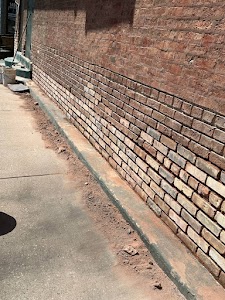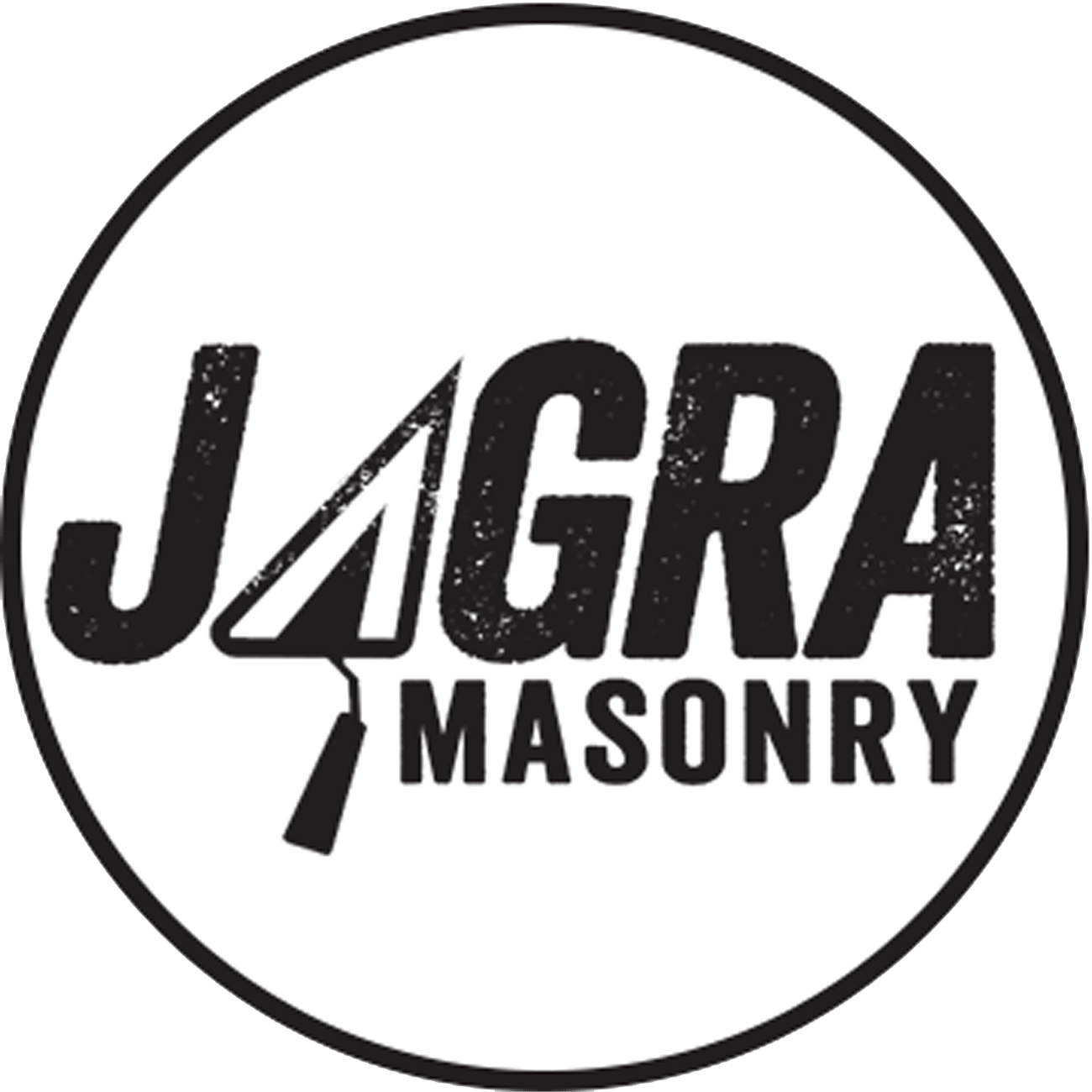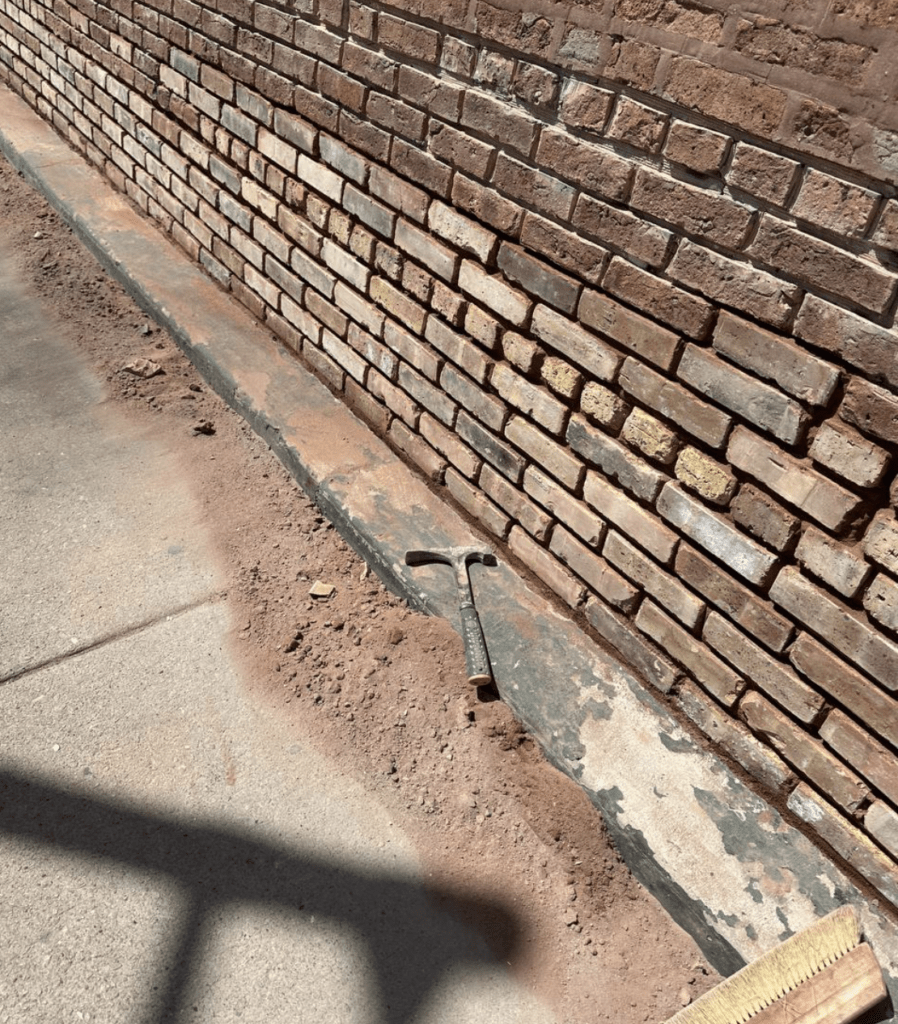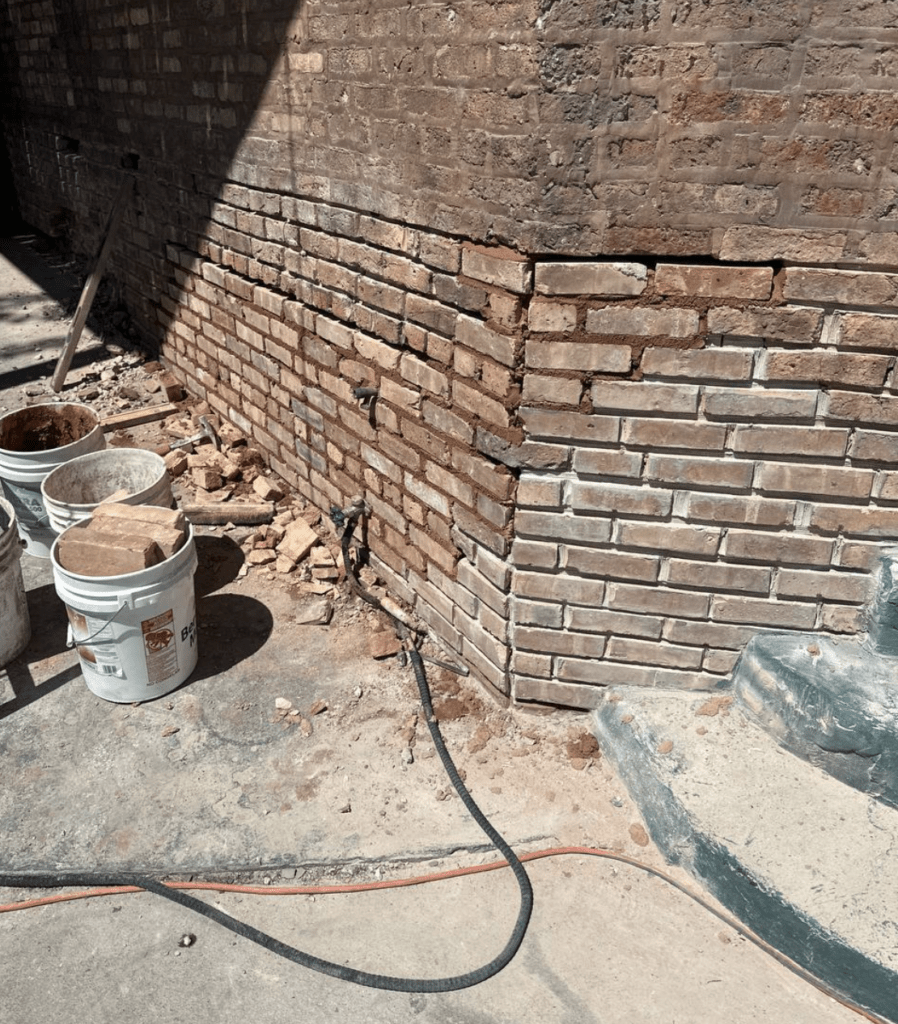What is Tuckpointing?
Tuckpointing Chicago properties is often described using 3 different terms. Many of us use these interchangeably as if they mean the same thing although they are quite different from one another.
Tuckpointing, also known as tuck pointing, is a technique used to repair or restore brick structures. The process involves carefully removing the damaged or deteriorated mortar from the joints between the joints between the bricks and replacing it with new mortar. The new mortar used for the process is typically composed of two separate mixtures, one that closely matches the color of the bricks and another contrasting thinner line.
During the tuckpointing process, the color matched mortar is used to fill the joint completely and the contrasting colored mortar is then carefully applied on top, creating a thin line. This technique creates the illusion of a fine, tight joint between the bricks and gives the wall a clean and uniform appearance.
Pointing is the process of filling and shaping the visible part of the mortar joint between masonry units. It is a crucial step in maintaining the structural integrity of a building and preventing water damage. In older buildings, pointing may need to be done periodically to infill missing mortar.
Repointing is the process of removing (grinding out) old, damaged mortar and replacing it with new mortar. Unlike pointing, where only the surface of the joint is repaired, repointing involves removing a significant amount (usually ¾ of an inch) of the old mortar and replacing it. This process is typically more extensive and invasive than pointing, and is usually only done when the existing mortar is severely damaged or missing.
Many people use tuckpointing as a blanket term when requesting a service, when they are in fact referring to re-pointing – the most commonly required service for Chicago brick buildings.
What is Tuckpointing?
Tuckpointing Chicago properties is often described using 3 different terms. Many of us use these interchangeably as if they mean the same thing although they are quite different from one another.
Tuckpointing, also known as tuck pointing, is a technique used to repair or restore brick structures. The process involves carefully removing the damaged or deteriorated mortar from the joints between the joints between the bricks and replacing it with new mortar. The new mortar used for the process is typically composed of two separate mixtures, one that closely matches the color of the bricks and another contrasting thinner line.
During the tuckpointing process, the color matched mortar is used to fill the joint completely and the contrasting colored mortar is then carefully applied on top, creating a thin line. This technique creates the illusion of a fine, tight joint between the bricks and gives the wall a clean and uniform appearance.
Pointing is the process of filling and shaping the visible part of the mortar joint between masonry units. It is a crucial step in maintaining the structural integrity of a building and preventing water damage. In older buildings, pointing may need to be done periodically to infill missing mortar.
Repointing is the process of removing (grinding out) old, damaged mortar and replacing it with new mortar. Unlike pointing, where only the surface of the joint is repaired, repointing involves removing a significant amount (usually ¾ of an inch) of the old mortar and replacing it. This process is typically more extensive and invasive than pointing, and is usually only done when the existing mortar is severely damaged or missing.
Many people use tuckpointing as a blanket term when requesting a service, when they are in fact referring to re-pointing – the most commonly required service for Chicago brick buildings.
Why Would Your Chicago Bricks
Need Tuckpointing
In Chicago, Your mortar will erode and eventually crack due to a number of reasons
Why Would Your Chicago Bricks
Need Tuckpointing
In Chicago, Your mortar will erode and eventually crack
due to a number of reasons
Freeze-thaw Cycle
The repeated freezing and thawing of water in the mortar can cause it to expand and contract, leading to cracking and weakening of the mortar.
Temperature Changes
Chicago is know for it’s drastically varied seasonal temperatures that can have a negative impact on Your brick structures.
Water Erosion from Rain
The constant exposure of the building to water can cause the mortar to deteriorate and weaken, making it more prone to cracking.
Defects in the Roof
Leaks in the roof or membrane system can allow water to penetrate the building and cause damage to the mortar.
Defects in Flashing Systems
Defects in the flashing systems can also allow water to penetrate the building, causing damage to the mortar.
De-icing Salt
The use of de-icing salt on the roads and sidewalks can cause the salt to seep into the joints and deteriorate the mortar, as well as corrode any metal components in the building.
If Your joints are defective, water will infiltrate Your brick walls and quickly deteriorate several components of Your home, not only Your bricks and joints. This can result in brick damage, lintel(link) corrosion, interior leakage, or even structural masonry damages.
If Your joints are defective, water will infiltrate Your brick walls and quickly deteriorate several components of Your home, not only Your bricks and joints. This can result in brick damage, lintel(link) corrosion, interior leakage, or even structural masonry damages.
Good to Know
The Chicago Tuckpointing Process
Remove the Old Mortar
Using a hammer and chisel, rotary hammer, or an angle grinder with a mortar raking blade, carefully remove the old mortar from the bricks. Be sure to remove all the loose and deteriorated mortar, taking care not to damage the bricks themselves.
The depth of the joint grinding is a crucial factor to consider when tuckpointing. If the joints are not ground out enough, the new mortar will not bond properly with the existing brick or stone.
Washing
Once the surfaces have been cleared of masonry debris, the next step is to thoroughly wet the surfaces with water. The purpose of wetting the surfaces is to ensure that they are clean, which will help the new mortar to adhere better.
Apply the New Mortar
The third step in the repointing process is the application of new mortar, which is a slow and precise effort. Special hand tools such as a pointing trowel, a tray, and a mortar jointer are used to ensure that the joints are filled flush with the wall surface. Giving mortar joints the desired shape and brushed appearance, resulting in a clean, smooth and visually pleasing final effect.
The Benefits of Maintaining Your Mortar – What Happens if you Don’t?
Maintaining the mortar joints in Your building is crucial for preserving its structural integrity, increasing its value and preserving its aesthetic appeal. Tuckpointing is a process that can help to repair and restore the mortar joints in masonry structures, such as brick or stone buildings. However, the success of a tuckpointing project can be impacted by several factors.
The quality of the mortar is another important factor to consider. Using low-quality mortar can result in a weaker bond between the new and existing mortar, which can lead to cracking and failure over time. It’s important to use the right type of mortar for the job and to match the color and texture of the existing mortar as much as possible.
The temperature at the time the work is performed is also an important factor. Mortar should be applied in temperatures between 40-90 degree Fahrenheit, as applying it in extreme temperatures can result in poor curing and affect the strength of the bond between new and existing mortar.
Finally, the condition of Your bricks is a key factor in the success of a tuckpointing project. If the bricks are cracked or damaged, they may need to be repaired or replaced before tuckpointing can be done. This will ensure that the new mortar is applied to a sound and stable surface, resulting in a better bond and a longer-lasting repair.
How Much Does Tuckpointing and Repointing Cost?
Tuckpointing and repointing are important steps in maintaining the structural integrity and aesthetic appeal of Your building. Many homeowners and property managers may be wondering about the cost of these services in Chicago. The cost of Chicago tuckpointing (repointing) can vary depending on a number of factors, including the size of the building, access to damaged sections, and exposure to public ways.
On average, Chicago tuckpointing (repointing) can cost anywhere from $9 to $21 per square foot. These estimates are based on the assumption that Your bricks are in good condition and that only the mortar needs to be repaired. If the brick or stone is also damaged, the cost may be higher. The cost of tuckpointing and repointing can also be affected by the type of materials used and the difficulty of the job.
These estimates are averages and the actual cost may vary depending on the specific project.
To give You a better understanding of Chicago tuckpointing (repointing) and pricing please refer to the examples below. These examples may have been completed within the last couple of years and are provided using current pricing and estimates rather than what they may have cost in the past. This is done to give You the best and most accurate idea possible.
Good to Know
The Chicago Tuckpointing Process
Remove the Old Mortar
Using a hammer and chisel, rotary hammer, or an angle grinder with a mortar raking blade, carefully remove the old mortar from the bricks. Be sure to remove all the loose and deteriorated mortar, taking care not to damage the bricks themselves.
The depth of the joint grinding is a crucial factor to consider when tuckpointing. If the joints are not ground out enough, the new mortar will not bond properly with the existing brick or stone.
Washing
Once the surfaces have been cleared of masonry debris, the next step is to thoroughly wet the surfaces with water. The purpose of wetting the surfaces is to ensure that they are clean, which will help the new mortar to adhere better.
Apply the New Mortar
The third step in the repointing process is the application of new mortar, which is a slow and precise effort. Special hand tools such as a pointing trowel, a tray, and a mortar jointer are used to ensure that the joints are filled flush with the wall surface. Giving mortar joints the desired shape and brushed appearance, resulting in a clean, smooth and visually pleasing final effect.
The Benefits of Maintaining Your Mortar – What Happens if you Don’t?
Maintaining the mortar joints in Your building is crucial for preserving its structural integrity, increasing its value and preserving its aesthetic appeal. Tuckpointing is a process that can help to repair and restore the mortar joints in masonry structures, such as brick or stone buildings. However, the success of a tuckpointing project can be impacted by several factors.
The quality of the mortar is another important factor to consider. Using low-quality mortar can result in a weaker bond between the new and existing mortar, which can lead to cracking and failure over time. It’s important to use the right type of mortar for the job and to match the color and texture of the existing mortar as much as possible.
The temperature at the time the work is performed is also an important factor. Mortar should be applied in temperatures between 40-90 degree Fahrenheit, as applying it in extreme temperatures can result in poor curing and affect the strength of the bond between new and existing mortar.
Finally, the condition of Your bricks is a key factor in the success of a tuckpointing project. If the bricks are cracked or damaged, they may need to be repaired or replaced before tuckpointing can be done. This will ensure that the new mortar is applied to a sound and stable surface, resulting in a better bond and a longer-lasting repair.
How Much Does Tuckpointing and Repointing Cost?
Tuckpointing and repointing are important steps in maintaining the structural integrity and aesthetic appeal of Your building. Many homeowners and property managers may be wondering about the cost of these services in Chicago. The cost of Chicago tuckpointing (repointing) can vary depending on a number of factors, including the size of the building, access to damaged sections, and exposure to public ways.
On average, Chicago tuckpointing (repointing) can cost anywhere from $9 to $21 per square foot. These estimates are based on the assumption that Your bricks are in good condition and that only the mortar needs to be repaired. If the brick or stone is also damaged, the cost may be higher. The cost of tuckpointing and repointing can also be affected by the type of materials used and the difficulty of the job.
These estimates are averages and the actual cost may vary depending on the specific project.
To give You a better understanding of Chicago tuckpointing (repointing) and pricing please refer to the examples below. These examples may have been completed within the last couple of years and are provided using current pricing and estimates rather than what they may have cost in the past. This is done to give You the best and most accurate idea possible.
Your Journey Starts Here
Explore Our Collaborative Process
Join hands with Jagra Masonry
for Your next project.
Your Journey Starts Here
Explore Our Collaborative Process
Join hands with Jagra Masonry
for Your next project
What Set’s Us Apart
Where Professionalism Meets
Personalized Service
What Set’s Us Apart
Where Professionalism Meets
Personalized Service
Premium Service
At Jagra Masonry, we pride ourselves on providing premium service. Our dedicated workers are committed to delivering consistent, high-quality work to our valued customers. Your satisfaction is our priority, and we strive to exceed Your expectations with every project.
Communication
When You choose Jagra Masonry, our dedication to quality ensures clear communication and transparent services, keeping You informed and at ease. We aim for outstanding results, always prioritizing Your satisfaction and keeping You well-informed throughout the process.
Fast Response Time
You can trust our service team to respond promptly to Your inquiries, ensuring Your needs are addressed quickly and effectively. We prioritize Your satisfaction and are committed to providing attentive support tailored to Your requirements.
Testimonials
Experience The Difference” Hear from
Satisfied Chicago Homeowners
Testimonials
Experience The Difference” Hear from
Satisfied Chicago Homeowners

More Services
Grinding & Tuckpointing
Brick Restoration & Repair
Chimney Repair & Rebuilding
Lintel Replacement
More Services
























































